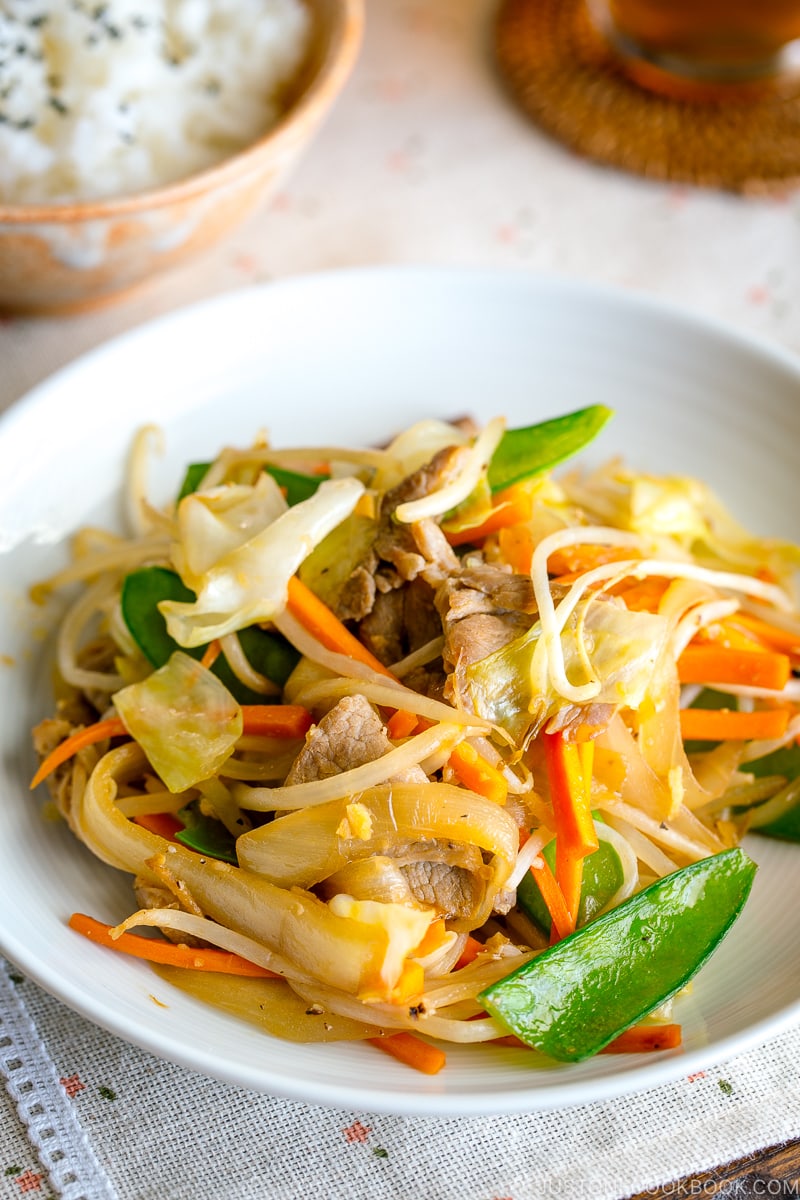Table of Contents
Embark on a culinary journey to the heart of Japanese cuisine with our curated collection of vegetable recipes. Whether you're a seasoned home cook or just starting your culinary adventures, these easy-to-follow recipes will guide you in creating delicious and authentic Japanese dishes. From vibrant stir-fries to refreshing salads, our recipes cater to various tastes and skill levels. Prepare to tantalize your taste buds and immerse yourself in the flavors of Japan with Nippongardening.com.
Japanese Vegetable Recipes: Easy, Healthy, and Authentic Dishes for Beginners
Easy Japanese Vegetable Recipes
Quick and Simple Stir-fries
Japanese stir-fries, known as "stir-fried vegetables" or "yasai itame," are a staple of home cooking in Japan. These dishes are incredibly easy to make and can be tailored to your taste preferences. Simply heat some oil in a wok or large skillet, add your favorite vegetables (such as broccoli, carrots, bell peppers, or snap peas), and stir-fry until tender. Season with soy sauce, mirin, and sake for a classic Japanese flavor profile.
Recipe | Cook Time | Difficulty |
Broccoli and Carrots Stir-Fry | 15 minutes | Easy |
Bell Pepper and Snap Pea Stir-Fry | 10 minutes | Easy |
Mixed Vegetable Stir-Fry | 15 minutes | Easy |
Refreshing Salads
Japanese salads are typically light and refreshing, featuring fresh vegetables, seaweed, and a simple dressing. One popular salad is "sunomono," which combines cucumber, carrot, and wakame seaweed in a tangy vinegar-based dressing. Another favorite is "gomaae," a spinach salad with a creamy sesame dressing. Both of these salads are easy to make and can be served as a side dish or a light lunch.
- Sunomono: This salad is made with cucumber, carrot, and wakame seaweed in a tangy vinegar-based dressing.
- Gomaae: This salad is made with spinach and a creamy sesame dressing.
- Edamame: These are immature soybeans that are boiled and served with salt.
Easy Japanese Vegetable Recipes
Healthy Japanese Vegetable Recipes
Steamed Vegetables
Steaming is a healthy cooking method that preserves the nutrients and flavors of vegetables. Japanese steamed vegetables are typically served with a simple dipping sauce made from soy sauce, mirin, and sake. Some popular vegetables to steam include broccoli, carrots, cauliflower, and green beans.
Recipe | Cook Time | Difficulty |
Steamed Broccoli with Garlic and Soy Sauce | 10 minutes | Easy |
Steamed Carrots with Ginger and Honey | 10 minutes | Easy |
Steamed Cauliflower with Cheese Sauce | 15 minutes | Easy |
Grilled Vegetables
Grilling is another healthy cooking method that brings out the natural flavors of vegetables. Japanese grilled vegetables are often brushed with a simple marinade made from soy sauce, mirin, and sake. Some popular vegetables to grill include eggplant, zucchini, bell peppers, and mushrooms.
- Grilled Eggplant with Miso Glaze: This dish is made with grilled eggplant slices brushed with a sweet and savory miso glaze.
- Grilled Zucchini with Teriyaki Sauce: This dish is made with grilled zucchini slices brushed with a teriyaki sauce.
- Grilled Bell Peppers with Olive Oil and Herbs: This dish is made with grilled bell pepper slices brushed with olive oil and herbs.
Healthy Japanese Vegetable Recipes
Japanese Vegetable Recipes for Beginners
Easy and Delicious Vegetable Dishes
If you're new to Japanese cooking, don't be intimidated! These beginner-friendly recipes will help you create delicious and authentic Japanese vegetable dishes. With simple ingredients and easy-to-follow instructions, you'll be able to impress your friends and family with your culinary skills.
- Stir-fried Vegetables: A quick and easy way to cook vegetables, stir-fries are a staple of Japanese home cooking. Simply heat some oil in a wok or large skillet, add your favorite vegetables, and stir-fry until tender. Season with soy sauce, mirin, and sake for a classic Japanese flavor profile.
- Salads: Japanese salads are typically light and refreshing, featuring fresh vegetables, seaweed, and a simple dressing. One popular salad is "sunomono," which combines cucumber, carrot, and wakame seaweed in a tangy vinegar-based dressing. Another favorite is "gomaae," a spinach salad with a creamy sesame dressing.
- Steamed Vegetables: Steaming is a healthy cooking method that preserves the nutrients and flavors of vegetables. Japanese steamed vegetables are typically served with a simple dipping sauce made from soy sauce, mirin, and sake. Some popular vegetables to steam include broccoli, carrots, cauliflower, and green beans.
- Grilled Vegetables: Grilling is another healthy cooking method that brings out the natural flavors of vegetables. Japanese grilled vegetables are often brushed with a simple marinade made from soy sauce, mirin, and sake. Some popular vegetables to grill include eggplant, zucchini, bell peppers, and mushrooms.
Tips for Cooking Japanese Vegetables
Here are a few tips to help you cook Japanese vegetables like a pro:
- Use fresh, high-quality vegetables.
- Cut vegetables into uniform pieces so they cook evenly.
- Don't overcook vegetables. They should be tender but still have a slight crunch.
- Season vegetables with simple sauces and seasonings to enhance their natural flavors.
- Serve vegetables immediately after cooking to enjoy them at their best.
Japanese Vegetable Recipes for Beginners
Authentic Japanese Vegetable Recipes
Traditional Japanese Cooking Techniques
Authentic Japanese vegetable recipes often employ traditional cooking techniques that have been passed down through generations. These techniques include:
- Simmering: Simmering is a gentle cooking method that involves cooking vegetables in a flavorful liquid over low heat. This method preserves the nutrients and flavors of the vegetables while infusing them with the flavors of the cooking liquid.
- Steaming: Steaming is a healthy cooking method that involves cooking vegetables over boiling water. This method preserves the nutrients and flavors of the vegetables while preventing them from becoming waterlogged.
- Stir-frying: Stir-frying is a quick and easy cooking method that involves cooking vegetables in a hot wok or skillet with a small amount of oil. This method results in vegetables that are tender-crisp and flavorful.
Popular Authentic Japanese Vegetable Dishes
Some popular authentic Japanese vegetable dishes include:
Dish | Description |
Nimono | A dish of simmered vegetables in a flavorful broth |
Mushimono | A dish of steamed vegetables |
Itamemono | A dish of stir-fried vegetables |
Tips for Cooking Authentic Japanese Vegetable Dishes
Here are a few tips for cooking authentic Japanese vegetable dishes:
- Use fresh, high-quality vegetables.
- Cut vegetables into uniform pieces so they cook evenly.
- Don't overcook vegetables. They should be tender but still have a slight crunch.
- Season vegetables with simple sauces and seasonings to enhance their natural flavors.
- Serve vegetables immediately after cooking to enjoy them at their best.
Authentic Japanese Vegetable Recipes
Final Thought
As you embark on your culinary journey with these Japanese vegetable recipes, remember that cooking is an art that flourishes with practice. Don't be afraid to experiment with flavors and techniques, and most importantly, enjoy the process of creating delicious and authentic Japanese dishes. Whether you're cooking for yourself, your family, or friends, these recipes will bring the flavors of Japan to your table, leaving a lasting impression on your taste buds.